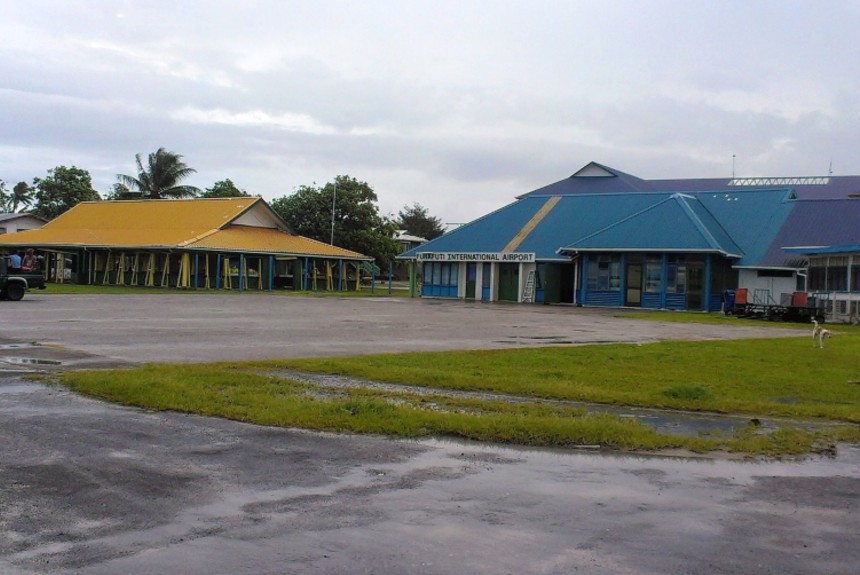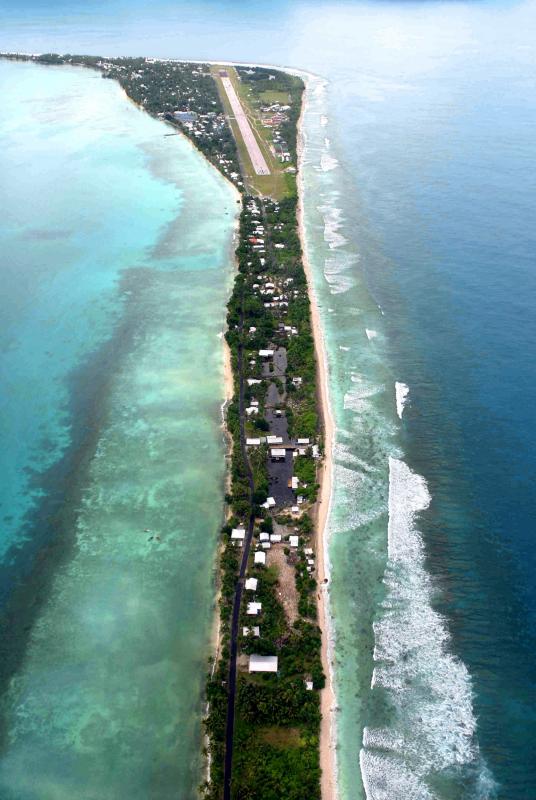
Airports are critical infrastructure for all countries as they connect us to the rest of the world for travel, commerce, and family with ever-increasing globalisation, Dr Theuns Henning stated in his case study on the Funafuti airport runway.
The Funafuti airport is in Tuvalu, an atoll island in the Pacific Ocean. Atolls are significantly vulnerable to climate hazards, so climate change has exacerbated these natural events.
The report says that the airport is critically significant for the community because it provides travel needs and links to work opportunities, medical care, and sometimes a link to relief services for its residents.

Funafuti International Airport near
top of the photo.
Tuvalu’s airport infrastructure damage can significantly affect the community’s economic and social aspects; thus, the airport must remain functional and operational.
In his case study, “Implications of Sea Level Rise on Coastal Pavement Infrastructure for the Funafuti Airport Runway,” Dr. Henning investigates these impacts on Funafuti’s runway and airport apron. Some of his observations include heaving on the runway’s surface and surface depression, as well as cracks and holes in the pavement.
Case study objectives
The case study aims to:
- For damaged runways and aprons, carry out detailed measurements on atmospheric pressures, vapour pressures, groundwater levels, and pavement properties to know the impacts of tidal fluctuations and atmospheric pressures on the airport pavement.
- To provide a basis for appropriate investments based on identified risks
- Come up with solutions specific to Funafuti Airport that can be applied to other airports located in low-lying areas.
Tests and findings at the Funafuti airport
Atolls are originally volcanic islands that get eroded over time until a ring-shaped coral reef island remains. The coral reef is porous, absorbs fresh water, and stores it beneath the ground like an aquifer.
Freshwater is less dense than saltwater and floats above saltwater during high tides and heavy rainfall, pushing the ground above it.
Tests were administered to monitor and measure water levels, vapour pressure, and surface temperatures in Funafuti airport. Data collected from these tests were analysed and used to determine the relationships of these elements in causing pavement rise.
The data collected shows that water table levels and sea tidal fluctuations are factors that can cause subsurface pressures, which can be enough to lift the pavement surface. Blistering on the surface is observed during spring tides, especially when they coincide with heavy rainfall.
Another factor contributing to blistering is the creation of vents when vapour escapes from the pavement and the surface temperature increases.
Findings from other airports
The study also examined other airports in similar situations and with the same problems with rising waters, most notably the Hong Kong Airport, Albany City Airport in the US, and the Barrow Island Airport in Australia.
Hong Kong airport is built on reclaimed soil layered with meters of rock fill and marine sand and covered with flexible asphalt and crushed aggregate pavement. Following a prolonged rain spell, the pavement heaved almost immediately after the airport opened, causing cracks and potholes.
After a rigorous investigation, it was found that the “heaving was caused by the build-up of air pressure underneath the pavement due to the rising tide and blockage of free airflow in the saturated capping sand layer.”
Both Albany Airport and Barrow Island Airport’s pavements experienced blistering. Similar pavement materials—double chip seal — are used for the two airports to provide a watertight surface.
They discovered that the built-up vapour pressure lifted the seal and caused the blistering. This was the same problem that was observed at Funafuti airport.
The only difference is that these two airports are inland with no tidal or sea-level factors and that the blistering was caused by vapour pressure from heavy and prolonged rainfall.
Data collected at Funafuti airport were analysed, and it was found that vapour pressure alone is not likely to cause blistering. Still, when it occurs with either of the following events: rising water levels, tidal peaks, or rainstorms, it can generate enough pressure or ‘peaks’ under the pavement to cause heaving and blistering.
What the case study recommends
Given the unique location and problem of Funafuti airport, which is subjected to high tidal levels, these are possible solutions being offered:
The Funafuti airport’s pavement materials and pavement itself are porous because they are of corral origin, so grouting for existing drainage paths is not advisable.
A watertight surface like asphalt paving will not work because rising tides, water levels, and vapour pressure below it will be sufficient to lift the pavement, similar to what happened in Hong Kong airport. Pavement heaving can further cause secondary failures like vent holes, surface cracks, and depression.
A mechanism to relieve pressure from beneath the surface must be provided, with subsurface side drains to remove water from the pavement quickly.
It is further recommended that the water table levels and vapour pressure be monitored. Also, a fishbone drainage system using a directional drilling technique should be installed without replacing the current base course, provided that the integrity of the base course is intact.
Lastly, more research is needed to develop low-cost permeable paving when water-table fluctuations exist.
To read the full report, CLICK on the link below:
PHOTO CREDITS:
World Bank Blogs. Dr. Christ Bennet. “Considering social impacts of investments in Tuvalu: is it a runway or a recreational area?.” Accessed 18 September 2019.
Meeting house and airport building by Rafael Ávila Coya – Own work, CC BY-SA 3.0, Link

